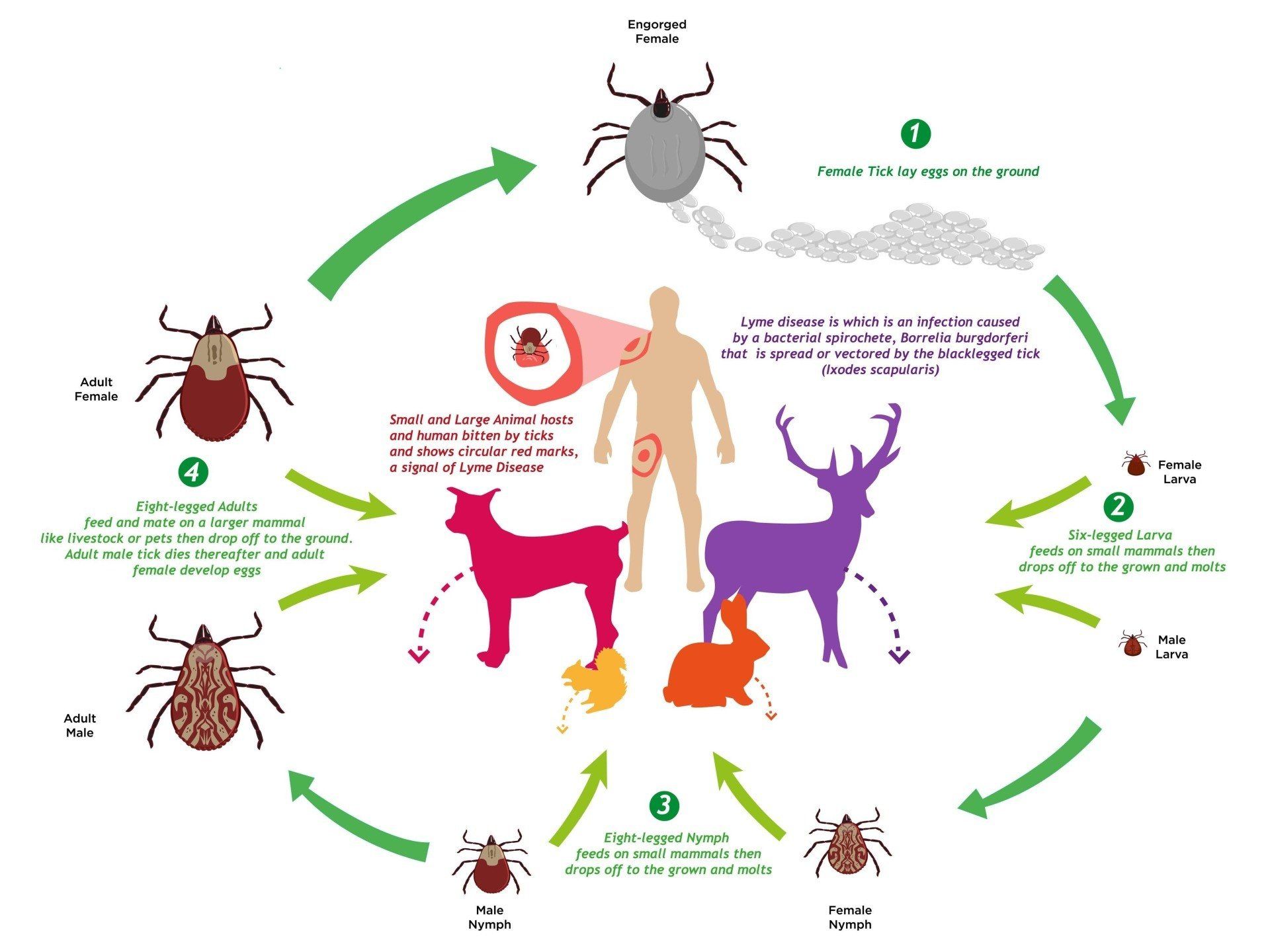Tick Life Cycle
Tick Lifespan and Life Cycle Growth Stages
Ticks have some of the longer lifespans within the insect world, surviving sometimes for as long as 3 years. During that lifespan, they will hatch from an egg and develop through 3 different tick stages of their life cycle. They will emerge as larvae before developing into a nymph and then finally maturing into an adult tick. In order for ticks to reach adulthood, each stage is preceded by a healthy blood meal that provides ticks with the right nutrients and proteins they need to develop. The problem with this is that ticks are vectors for serious tick-borne diseases like Lyme disease and Rocky Mountain Spotted Fever.
Tick Life Span
A tick’s life span depends largely on the tick species and how long it takes them to reach the next stage of their lives. Typically, most ticks will live for 2 – 3 years as they develop from larvae into mature adult ticks. Each transition requires a feeding on their vertebrate host which will provide the tick with the iron, sodium, vitamins, and proteins they need to grow. Sometimes ticks will starve to death while waiting on a blood meal. Otherwise, ticks will eventually die off when they reach the stage where they can lay eggs. Male ticks will die off after mating while female ticks will die off after laying thousands of eggs.
Tick Life Cycle Stages

The life cycle of a tick starts when a mature female tick lays a batch of eggs. Each batch of eggs will contain thousands of eggs which then the eggs hatch into larvae. Not all larvae will survive but they will do what they can to find a blood meal so they can grow into nymphs and then mature adults.
List of Services
-
Stage 1: EggList Item 1
Tick eggs are laid by the thousands in springtime as adult female ticks reach the final stage of their life cycle. They are found in areas that are dark, warm, and hidden from potential predators but still close enough to paths where they will be near potential hosts. They are often laid in leaf piles and other debris which is why ticks are more prevalent in wooded areas. Ticks need to unlatch from their host to lay their eggs so you won’t find tick eggs on an animal like you would other blood sucking insects like fleas. These eggs are typically small and translucent with a red or brown tint.
-
Stage 2: LarvaList Item 2
By the start of summer, the eggs will have hatched into 6-legged tick larvae. These larvae are not typically born infectious but in rare cases, transovarial transmission occurs where tick borne illnesses are passed from adult ticks to their eggs. What happens normally is that larvae will become infected after feeding on the blood of a host that carries a dangerous disease. Tick larvae will often feed on rodents like white footed mice since they are close to the ground. These types of hosts tend to carry diseases like Lyme disease in their blood which can pass on when the tick bites. Once they are infected, tick larvae will remain infectious throughout the rest of the stages of their life cycle. When a tick becomes infected, this is known as transstadial transmission, and they will be able to infect any host they feed on in the future. Tick larvae growth peaks by late summer when they will be looking to feed. Several ticks may not reach the next phase of their life cycle due to not being able to find a host but those that do will develop into nymphs after a blood meal.
-
Stage 3: NymphList Item 3
Sometime during the fall, tick larvae will have found a host to feed on. After this point, they will develop into tick nymphs. They will develop their final set of legs and lay dormant in leaf piles and under dense brush while the winter period of colder temperatures pass. Once temperatures start to rise above 37 degrees Fahrenheit in the spring, tick nymphs will become active and start their search for their next blood meal. At this stage, tick nymphs will spend the rest of spring and summer searching for food as they start to climb upwards on tall grass and shrubs. They place themselves strategically in locations where they are likely to cross paths with a new larger host like deer, moose, and even humans. Once they reach the tip of a blade of grass or branch, they will extend their new front legs in a position called “questing” which allows them to grip onto the fur or clothing of an unsuspecting host. Once they are attached to a host, tick nymphs will typically feed for 4 – 5 days before unlatching and falling off. If a tick is already a carrier of a disease from when it was infected as larvae, it is possible for them to be infected with another disease. This co-infection can then be passed onto to the final host that is fed on after a tick develops into a mature adult.
-
Stage 4: AdultList Item 4
By the end of the 2nd summer, as long as ticks are able to find a blood meal, tick nymphs will start their transition into adulthood. During the fall, the fully developed adults will start their search for their final host. By this time, several diseases can be carried by the adult ticks which make them particularly dangerous to animals and humans. In the northeast region of the US, it is said that 45% of ticks are carriers of Lyme disease. If a host isn’t found before temperatures drop, the adult ticks will find a place to hide and lay dormant until springtime comes back around. If they are able to find a host in the spring, the adult ticks will be ready to start producing eggs. Both males and females will be looking to mate at this point to start the final step of the life cycle of a tick. Males will die right after mating while females will produce thousands of new eggs and then perish shortly after.
How Many Hosts Do Ticks Need to Develop?
Most ticks are 3 host parasites that require ticks to disengage from their host after each feeding. That being said, there are also 2 host ticks and 1 host ticks that exist. 2 host ticks will remain on their hosts during their larval and nymph life stages before disengaging to develop into an adult. 1 host ticks will remain on their host for their entire lives and only disengage after mating to lay eggs.

















